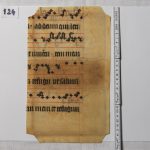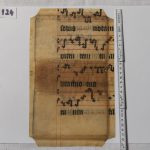The Pauline Library of the Central Seminary Library keeps three fragments from the same 15th-16th century Pauline gradual: in the Fragmenta catalogue (see Bibliography) these fragments are numbered consecutively (Fr. l. m. 122, 123, 124). All three of them covers books of the Jesuits of Pozsony (Bratislava in present-day Slovakia). The volumes came to Buda, then Pest in the times of the abolition of the religious orders under Joseph the II. The corners of the resected leaves are cut off. This group of fragments is of particular value to us, since we can only form a picture of the Gregorian Mass tradition on the basis of musical codex fragments, as no complete Pauline gradual has survived from the Middle Ages. Besides these gradual fragments, the Library of the Hungarian Academy of Sciences has another signficant fragment group of ten complete and incomplete leaves from another Pauline gradual: these fragments can be dated earlier than that of the Pauline Library based on the quality of the notation and the earlier stage of stylization. The two graduals together provide a valid picture of the development of the Pauline notation in the 15th century.
All three gradual fragments in the Pauline Library were cut from the pars temporalis volume. They contain sections close to each other in their content: the proper chants of the Masses for Epiphany and Shrovetide. On the first fragment, a large part of the gradual (Benedictus Dominus Deus Israel) and the offertory (Iubilate Deo omnis terra) of the first Sunday after Epiphany can be legible, and the communio (Fili quid fecisti) is also distinct. Only the upper part of the blue F-capital and a punctum and clivis from the beginning of the melody survive, but this two offers sufficient evidence for the identification of the chant.
The order of the chants is not surprising, the generally fixed order can be reconstructed from them. One musical peculiarity, however, may be documented: the final note of the Iubilate Deo offertory closes the melody on e, according to the Mode 3, albeit the entire melody moves in the range of the Mode 1. This tonal ambiguity is not a local, but rather a regional variant: e.g. the same final note is also found in Polish sources. It should be noted here, that besides the solutions above, a version in Mode 8 can also be documented in Western European (e.g. French) codices, but here too only the final note differs: instead of the aforementioned d or e closures, a g closure occurs. This malleable formula illustrates the shortcomings of the Gregorian tonal system and the inaccuracy of the definitions based on the final note.
The mass chants of the Dominica Sexagesima and Quinquagesima are visible on the fragments F 853 and F 854, which are very close to the liturgical site that can be seen on fragments F 852 (Dominica I post Epiphaniam). This justifies the assumption of a simultaneous book binding. F 853 and 854, which are about a quarter of a folio in size, are closely related in content: they were originally a strip of folio together, which was cut in half to cover the smaller books and then tailored to the dimensions of the given volume (i.e. the two fragments are not of the same width). The notes of the gradual Tu es Deus are perfectly fitting together at the cut, thereby the written height of the original codex is also determinable: 450 mm (ie. the F 582 preserved the full with). After reconstruction, it is thus possible to know that the leaves originally contained eight lines of text and notation. The data suggest a harmonious, airy arrangement. The folios were not crowded, unlikely to the earlier Pauline musical sources (see e.g. the gradual fragments of the Library of the HAS, or the Pauline Library’s Vesperal fragment-pair, Fr. l. m. 97, 103, here F 685, 691). On the verso of the leaves, in addition to the gradual of Dominica Quinquagesima, a great part of its introit can be reconstructed. The recto sides reveal the immediate liturgical antecedent: F 853 and F 854 shows parts of the offertory (Perfice gressus meos) and communio (Introibo ad altare) of Dominica Sexagesima, and also the beginning of Dominica Quinquagesima’s Introit (Esto mihi).
The melodies follow as closely as possible the 14th-century Esztergom version, which can be found e.g. in the Missale Notatum Strigoniense (http://cantus.sk/source/16685; see also the online melody catalogue Melodiarium Hungariae Medii Aevi Digitale, which publishes the chants of Hungarian sources by genre: http://melodiarium.zti.hu/cantus-missae/). There are minor differences in the distribution of neumes, and the chronology may mean that certain additional signs have disappeared from practice and neumes are simplified (e.g. the liquescens, strophicus, cephalicus, pre- and postpuncta).
The fact that it is a Pauline graduale can be ascertained from the musical notation. The highly stylized, Gothic Pauline neumes of the late 15th century are visible on the parchment, a late Esztergom musical notation that is well known and documented in Hungarian Gregorian palaeographical research. What makes this Pauline notation, maintained by three fragments, unique compared to other notations form the Paulines, is that the earlier rounded Esztergom forms are no longer visible here. The pliable character of 14th-century Esztergom notation was faithfully preserved by the Pauline copyists even in the earlier years of the 15th century, although it is difficult to create curved forms with thick pen strokes (good examples are the coherent Vesperale fragments of the Pauline Library, Fr. l. m. 97 and 103). But then sharp turns, stiff neume forms catch one’s eyes on the fragment, as if the flexibility had been sacrificed to legibility and uniformity. The change in neume shapes is perhaps explained by the fact that the original folio size seems larger than usual, hence the writing can only be held together with thickly drawn elements, which comfortably could fit on the staves. It is clear that the notes are more regular and unattached rhombus than any previous Pauline basic sign. Their appearance becomes the main aspect during the copying process, just look at the shape of the porrectus or climacus, where a punctum almost detaches from the original neume – something that has never been done before. The decorative Pauline notation of the fragments would therefore be dated to the end of the 15th or beginning of the 16th century. On the basis of the surviving sources, this type of notation can be considered the last stage, the culmination of the development of late Esztergom/Pauline notation, a more standardized version of this type cannot be registered elsewhere. It can be seen, however, that the neume set does not definitively surrender to the contemporary Messine-German gothic manner of writing: the numerous vertical point series recall old Esztergom memories and are still striking elements, and the continuous writing of the neume combinations (e.g. torculus resupinus) without lifting the pen is also an archaism. (See Gabriella Gilányi, ˝Preservation and Creation. Plainchant Notation of the Pauline Order in 14th–18th-century Hungary”, Studia Musicologica 59/3–4 (December 2018), 399–417).
Unfortunately, this notation could not reach the phase of printing. The Turkish occupation, which took place a few years later, destroyed the network of the Pauline institutions in Hungary with its scriptoria in the central regions of the country.
Gabriella Gilányi



